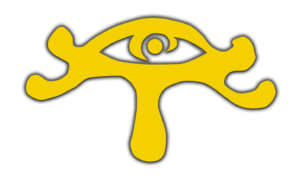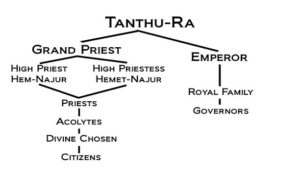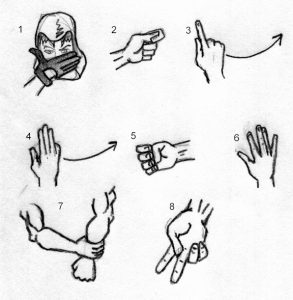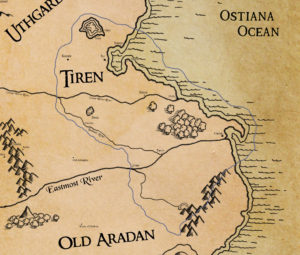Small square buildings on the city’s edge were once the grand idea of the city to house newcomers as they settled in the city for jobs. Once they had earned some cash, these newcomers would move to another ward. As the city declined, this became a section of town that was neglected and forgotten. The Tower did not ever tax these dwellings, so they grew and became a ward in their own right. Now people live here to avoid the taxes and oversight of the other wards.
Archives
The Star of Lost Love
Torches flickered among the windows and archways of the treetop building. The elder elf, in his deep, melodious tone, began his next tale.
“Now we shall talk about Gilandras. I tell not of his slaying of the last great wyrm, or even of his long protection of the elven races. Instead we shall speak of his last encounter in this world, with a force even he could not withstand.
“As you all know, Gilandras often ventured out into the wild forests searching for the evil beasts of Unhamil, and sometimes he would spend years alone on the hunt. One hunt on a summer night such as this, under the same stars you see above, he was resting in a clearing when he heard a song unlike any he had heard before. It came from the trees and flowed out across the clearing, the sounds as sweet as a summer rain. He stayed still so as not to surprise the voice that evoked such emotion in him. He heard in this melody the praise of all that grew, of the creeks and rivers which fed the roots of the forest. He heard an homage to the sun and moonlight that gave the lands warmth. And as he stood perfectly still, lost in the melody, the singer emerged from the trees before him. She struck him instantly as the most beautiful woman he had ever seen. Her raiment was that of simple green cloth, though it sparkled as if silver was sewn into it. She danced into the clearing, her graceful movements matching the song. And where she stepped flowers grew up as if trying to caress her.
“It was then that Gilandras stood and began his own song. For a brief moment, their songs became one, but upon recognizing this second melody, she stopped and ran, fast as a deer, back into the woods and was gone.
“He chased her but could find no tracks, nor did he hear her footsteps. He searched for weeks, but to no avail. Years passed, and he was set about many tasks by his elven lords, but he never forgot her. Each night, in the wilderness, he would sing out to her and of his love for the world that her song had inspired.
“One night, at the beginning of Fall, he was singing when he noticed a second melody had joined his. He rose and walked in the direction of the second voice, careful not to stop his own melody. Through a dense patch of trees he passed, and then into a clearing which contained a small waterfall at the far end. There, the elf maiden sang, though this time she looked at him and smiled. She held out her hand, and Gilandras took it in his. They moved through the forest, singing and dancing for the rest of the night, and then lay down in the fields to watch the stars.
“Gilandras fell fast asleep, and in the morning, his companion was gone. Through the day he searched for her, until dusk and then night came, and she returned to him again, singing and dancing under the stars and silvery moonlight. Countless were the nights they spent like this, until Gilandras found a desire to return home, and spoke to her for the first time of a feeling that was his own.
“He professed his love for her and asked that she return with him and be his wife. At this, she turned from him, her eyes filled with tears. She then turned to him and held him close as she whispered in his ear, revealing to him that she was not an elf, but Lunare, Goddess of Nature. Although the elves during this time lived very long lives, Galandras still was mortal, and she could not love him back in the same way.
“Gilandras walked back to his bow and quiver, and gathering them up, walked into the forest to the East after the bright red star that appears during the fall. He followed this star into the winter and was never seen again by the elves.”
The older elf pointed up at the red star now in the sky. “That is why we call that the Star of Ellos Amal, or the Star of Lost Love. When that star rises higher in the sky, you can see three stars rise up after it, for that is the Bow of the Hunter, forever chasing unattainable love. Now, there are many interpretations of this story, but indulge me by hearing mine. I believe the story means that although one may be great, one must always be diligent to not be led astray by temptation. Gilandras meant much to his people. He was their hero and their protector. But when his heart was broken, in his weakness, he left the world and his people behind to chase the unattainable. It is the wise who know their own weaknesses and face them rather than fleeing from them.”
The Undermeet
The Undermeet is a rumored market comprised of the worst merchants and darkest wares. People whisper of its existence, though most who brag to have been there cannot, or will not, tell how to get there. If there is something you need that is not sold in the Market District or even the Dirt Market—something vile or unmentionable—the Undermeet is where you get it. It is said it is not always in the same place, and it is not always open, but for contraband, rumored magical artifacts, or worse, the Undermeet is where you go to trade. The Undermeet is not controlled by any factions within the city, or at least no one wants to own up to being a part of such dark or despicable trading.
The Wizards of Ish

The eye of Tanthu-Ra, and the Symbol of the Najur
The Wizards of Ish, or Najur as they call themselves, keep their secrets close. Once trained they are never allowed to leave the ranks of the Sorcerers. Of all the magic groups, theirs was the most untouched during the Disappearance and their stronghold in the center of Ish remains as it has for over a thousand years. But whatever knowledge they may have, they keep to themselves.
Much like the rest of the Ishian Empire their policies are strict, and death of slavery is a just punishment.
One of the biggest differences between the Wizards of Ish and the majority of other magic using groups, is their use of slaves as power reservoirs for magic. Powerful wizards can have a stable of slaves, blank eyed and pale, who are kept on leashes as a source of power for their magic.
Ansely, Mage of Eredar, Eastlands
From the Encyclopedia Atheles
“We are all but servants.”
Ishian wizards view themselves as conduits of God, and therefore as priests instead of workers of arcane magics. The wizards of Ish call themselves the Najur, an ancient word for servant. They, like most in the Ishian Empire, worship Tanthu-Ra, a sun deity. This is why all in the priesthood wear yellow robes.
They are ranked very high within the culture of Ish, with the Grand Priest even being considered higher than the Emperor.
They occupy the Temple of the Sun, a large squat building made of black stone.
They take volunteers from the citizenry to give themselves to God. This means that they willingly become vessels for the wizards to take energy from for spell casting. The Najur see them as disciples, who become vessels to the all power of Thanthu-Ra.
Thieve’s Cant
Thieve’s Cant for the Beginning Rogue
Taught by Tritam Swifthands
- One of the more common signs for letting another rogue know your profession. You do it by rubbing the palm across the bottom half of the face. There are other ones, but this is the most common.
- What the speaker says is important and should be listened to. This is also another way for you to let another know you are a rogue. It is done by placing the thumb into the forefinger while balling the fist.
- This one means that the territory you are in is claimed. Work the profession at your own risk. If you cross the path of the current “owner” of the area doing your personal “business” it will probably rub him the wrong way. While most guilds will allow you to do some freelance business, most don’t let an independent rogue set up shop in their town or city. It is done by placing the thumb and forefinger together, with the other three fingers clenched. Then you accompany it with a downward swoop.
- This swooping hand gesture means that whatever word the bearer brings is the word from the “higher power” of the area. Oft times this news or information comes from either a guildmaster, guild officer or a powerful thief in the area. It is done by extending all fingers except the pinky finger and doing a downward swoop.
- This signifies that this area is a safehaven or that the signing rogue is offering a safe haven. This is done by bringing the tops of the fingers to the thumb in somewhat of a fist.
- This one signs danger. It is done by extending all fingers and bringing together the middle and ring finger.
- Guards on the prowl or lookout. If you are looking to avoid official entanglement then you’d best be off elsewhere. It is done by balling up your left fist and grasping your left wrist with your right hand.
- This means that the powers that be in this area do not welcome you. Normally a quick exit of the area or city is the best move after seeing this. It is done by extending the index and middle finger and crossing them with your thumb.
Well that’s about it for now lad. Remember these well, as it can mean life or death…
Thundrom
Thundrom
Thundrom are large hairy beasts from the Swordspyne Mountains. They are used as mounts by the people of the mountains, but to most of those in the plains, the Thundrom seems exotic and strange.
Thundroms are a little larger and bulkier than a horse and are covered in shaggy brown hair. Their bodies resemble that of a yak in shape, but they have long tusks and even longer curled ramlike horns. Its head looks large for its body, its four nostrils the only exposed skin on this otherwise long haired beast.
The are used as mounts and beasts of burden by the people of the mountains and the Northeastern lands.
Thundrom
Challenge Rating: 2
Size: L
Type: Animal
Initiative: +3
Defense
Hit Points: 23 (2HD)
Armor Class: 17, touch 12, flat-footed 13 ( -1 size, +3 DEX, +4 natural armor)
Saves: Fort +8 Ref +7 Will +3
Weaknesses: –
Offense
Speed: 50’
Base Attack:
Melee: Bite +5 (1d6 + 3), slam +1 (1d8 + 2)
Ranged: –
Special Attacks: –
Sanity Effects: –
Statistics
Abilities: STR 20, DEX 16, CON 21, INT 2, WIS 17, CHA 9
Skills: Acrobatics +3, Athletics +5, Awareness +3, Endurance +5, Knowledge -, Persuasion -, Spellcraft -, Survival +5, Thievery +3
Talents: Endurance, Run
Special Qualities: –
Ecology
Environment: Mountains
Organization: Solitary, pair, herd (4-22)
Treasure: Standard
Timeline
Third Age – Age of Kingdoms or the Time of Man (Elven)
- 1 The first men are encountered by the Elves. They are barbaric and live in the deserts and arid lands that were left from the conquests of Kaldrath. The Elves at first believe them to be inferior and kin to goblins.
- 224 The first human cities are built. The Elves begin to take notice of their “barbaric” neighbors and even train them in crafts and skills. The humans excel in all and their cultures and population grow rapidly.
- 1789 The Dwarves awake from their slumber.
- 3174 The Druid council is formed in the North.
- 4134 TM The Empire of Ish (called the Ishian Empire in the North) is formed in what becomes known as the Southlands. The first emperor of Ish is Da’atra Tiria. The Tiria family still rules in Ish now.
- 4467 The city of Selardor is built. It is ruled by Adomar Aradan.
- 4526 Olaekin Baleband is born.
- 4558 Olaekin Baleband has conquered most of the North as a warlord, and builds the city of Pardalor.
- 4629 The Mages of the West are formed. Ruled by three wizards they congregate in a large keep( Keep of Ismaren in the Misty Moor, later called the Miragol Swamp) along the Western coast (Above the Vale of current times). Distrusted, they spend most of their time in solitude.
- 4656 Strange stories come from Pardalor. Stories of Orovari, orlocks, and goblins openly entering the town. The Orovari migrate north to the lands of Uthgard. House Ka’Dail begins to unite the tribes of Orovari. Questions about the King, Olaekin Baleband begin to arise. His unnaturally long life ( currently 130 years) and his seclusiveness earn distrust within those of the kingdom. He is also rumored to be a practitioner of black arts.
- 4695 Emperor Kalah of the Ish bans the use of books. During this time many of the ancient texts and tomes are burnt. He also empowers the people of the Jaldur desert, promising them their own nation if they rid the Wildelands of the elves. This leads to a genocide of the wild elves and though they finally push back and defeat the Jaldurians, they are left weakened and forever scarred.
- 4735 Some Mages split from from the keep and form the tower of Eredar in the east. The first archeons are trained to keep a watch on the powers of mages.
- 5054 Uthgard begins its war to control Atheles (The Great War, The Aradan War)
- 5057 Small border skirmishes between the Ishian Empire and Endamas begin.
- 5059 The Ishian Empire begins invading the Westlands.
- 5069 Olaekin Baleband, now known as the Warlock-King, defeats a large force of the Ishian Empire’s Army.
- 5073 The Ishian Empire, worn down by years of war, pull their troops back and fortify their borders. The elves stop their war, the high elves retreating into their forest and some of the grey elves and wood elves that are left lend their aid to Selardor.
- 5075 The Warlock-king and his armies march on Selardor itself.
- 5082 Selardor (Capital city of Aradan) is destroyed. The city is evacuated, including the king’s newlywed wife and his son. Aeerumar Aradan, last king of Selar Dor is slain by one of his advisors, Caroth. Uthgard uses an artifact to open a rift from the battlefield into the heart of the city, insuring victory.
- 5086 War on the West is declared by the Warlock King and his kingdom Uthgard
- 5087 Bordon repels Uthgard’s forces
- 5090 Invasion of Norhan (Northlands) almost reaches Seahaven and is repelled. Uthgard retreats and there is an uneasy peace for years.
- 5132 Second invasion by Uthgard. Seahaven and Bordon, with the help of the Ishian Empire push back the forces of Uthgard and the Warlock King is slain. He uses devastating magic again, ruining the Eastlands. The Disappearance happens.
The Fourth Age
- 5280 Years of hardship follow as the remnants of the Uthgard army are still strong and cause problems all along the North and Westlands. The Ishian Empire becomes solitary, allowing no traffic to and from their country. The process of rebuilding and relearning is slow.
- 5368 Empire of Zhouyin invade over the sea. Tyr falls under control of their empire. Lands of the Eastlands (Old Aradan and Uthgard) fall under the control of Zhouyin.
- 5402 The beginning of the Plague. The Zhouyin Empire falls in disarray. Many return back over the sea, and have not been heard from since.
- 5414 Knights of the White Eagle rise to power in the Northwest. They use their religious zealotry to sway people’s emotions during the outbreak of the second Plague.
- 5555 Fall of Grace of the Knights and their Church. Still powerful, but no longer in direct control of the Northan kingdom.
- 5629 The Third plague ravages Atheles, leaving the cities and kingdoms separated and superstitious.
- 5677 The first recorded instances of the Return.
- 5683 The Dark Return. Magic flows through the lands. Demons return to the murky forests. Long lost tribes appear on the horizon. Wars break out dubbed the Return Wars.
- 5684 The Return Wars end in the winter.
- 5685 The lands struggle to keep an uneasy peace. Norhan solidifies its rule of the northlands. Uthgard and Tiren sign an alliance which offers trade to all in the East. The Westlands settle back into comfortable city states looking to Bordon for leadership, but they do not swear fealty. The Ishian Empire opens its borders and allows small bits of traffic.
- 5698 South Keep, once a single fortress outpost along the Ishian border, starts to become a well known trade town in the West.
- 5707 Current day.
Tiren
Tiren
Country
Government: Military Regional
Economic System: Capitalism with heavy taxes
Population: Moderate, Dense
Notable NPC’s:
Notable Places: Tir (Tyr), Kamric, Harun, Dorn
Cariek, Arun
Ruled by region, sultans. Sultans are appointed from the military. The military is the Vicaries.
Exports : Wine, granite, textiles,
Magic: Open
The good: tolerant of religions, race, and culture. Gender equality
The bad: violent culture. Sports and entertainment are violence oriented. War is a cultural imperative.
Overview:
Tiren, the Kingdom of the rising sun, dominates the coastal region of the Eastlands. Its vast landscape is populated by many peoples, each governed as a small kingdom ruled by a militarily elected sultan.
The country is rich and its people live in comfort compared to some other regions. Engineering and mathematics are considered as holy as the gods, making cities and towns well designed, clean, and efficient. Laws are fair, but strict, with a constitutionally built judicial and punishment system.
Most of the people are of a darker brown complection, with dark straight hair. They favor light clothing made of silks and linen, though in winter furs and leather are common. The men favor a look with a long mustache, while women favor dark eye make ups and braided hair. All wear large wrapped fabric headpieces, often adorned with silver or gem jewelry.
The culture is healthy, as must have a balanced diet due to well established trade route throughout the realm.
Tyrians are also known for their sailing, and they trade all across Atheles.
From Jarin Plainswalker
This Kingdom has formed since the era of Aradan and is quite strong. It controls the access to the sea and has a brisk trade with the Far eastern lands.
Of note, the kingdom of Tiren is the only place in the east that a settlement of Elves live, though the exact location of this city is unknown. The small city is build among the cliffs and views the Inner Sea. This is in honor of Dalimar Gorfiriand, who led the elves against Kaldrath and helped lock him away. The prison was locked by the five Fengal Stones, one of which was given to Dalimar, who then went across the Inner Sea to safe guard the lands of the west.
- 4276 A warlord, Tyrimous, leads a strong calvary starts to bring together the small kingdoms of the northeast.
- 4285 Tyrimous officially forges the coastal nation of Tiren.
- 5368 Empire of Zhouyin invade over the sea.
- 5370 Tyr falls under control of their empire.
- 5379Lands of the Eastlands (Old Aradan and Uthgard) fall under the control of Zhouyin.
- 5402 The beginning of the Plague. The Zhouyin Empire falls in disarray. Many return back over the sea, and have not been heard from since.
- 5519 A peaceful trade contract is signed between Tiren and Zhouyin.
- 5629 The Third plague ravages Atheles, leaving the cities and kingdoms separated and superstitious
- 5647 In a bid to consolidate power, Sultan Emel declares war against the city states of Uthgard and the Free Cities.
- 5656 Sultan Emel dies in his sleep, the other sultans declare peace.
- 5711 Current day.
Toryn Ninefingers
Toryn is a significant historical hero of Uteria. Losing his parents to superstitious townspeople when he was a child set him on the path of a vagrant. The homeless musician who raised him set him on the path of a traveling minstrel.
In a world divided by people who would abuse magic on the one hand, and superstitious people who would destroy all magic on the other, Toryn’s life work is devoted to learning the truth, and to spreading that truth through music, magic, and storytelling.
Read more about Toryn in the fiction story by Dane Clark Collins: Crossroads of the Never.


